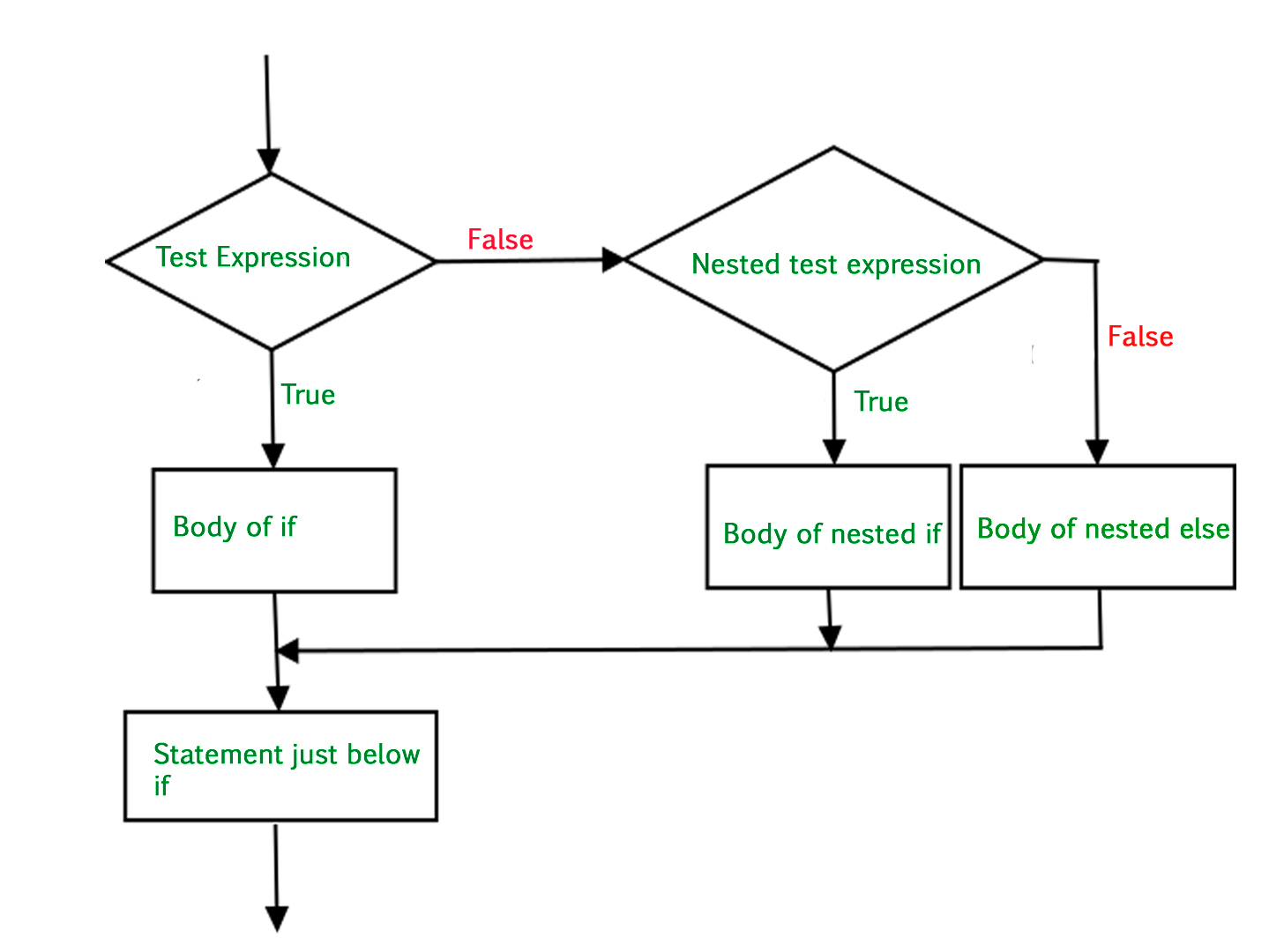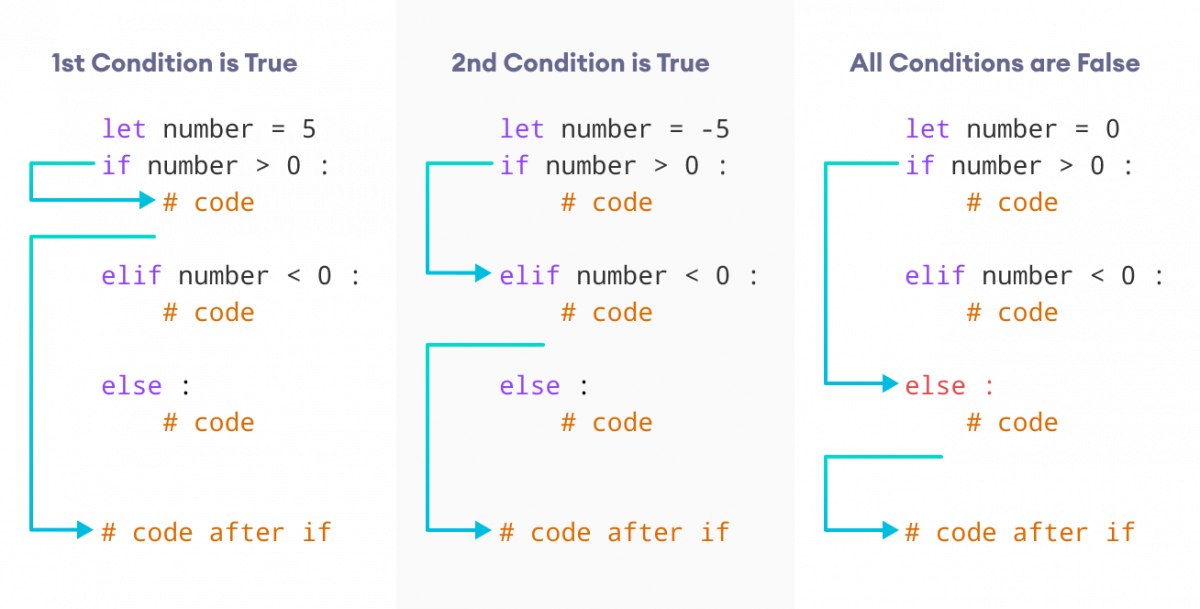Nested elif in Python
Nested elif in Python

I'm happy to help!
Nested if-else statements are used to execute different blocks of code based on the conditions specified within each clause. In Python, you can achieve this using nested if and elif statements.
Here's an example:
def check_age(age):if age < 18:
print("You're a minor.")
elif (age >= 18) and (age <= 64):
print("You're a adult.")
elif (age > 65):
print("You're a senior.")
else:
print("Invalid input.")
check_age(17)
check_age(25)
check_age(66)
In this example, the function check_age() takes an integer age as its argument. The function checks if the age is less than 18, and if so, prints "You're a minor.".
If the age is not less than 18 (i.e., it's 18 or greater), then the program moves on to check if the age is between 18 and 64. If it is, then it prints "You're a adult."
However, if the age is neither less than 18 nor within the range of 18-64 (i.e., it's greater than 65), then the program executes the final block of code and prints "You're a senior."
The elif statement allows you to check for additional conditions. If the first condition (age < 18) is not met, Python moves on to the next clause ((age >= 18) and (age <= 64)). This process continues until it finds a condition that is true.
Here's how you can nest multiple if and elif statements:
def check_weather(weather):if weather == "sunny":
print("Good day!")
elif weather == "rainy":
print("Take an umbrella!")
else:
if weather == "cloudy":
print("Clouds are gathering.")
elif weather == "windy":
print("Hold onto your hat!")
else:
print("Unknown weather.")
check_weather("sunny")
check_weather("rainy")
check_weather("cloudy")
check_weather("windy")
In this example, the function check_weather() takes a string argument weather. The function checks if the weather is "sunny", and if so, prints "Good day!".
If the weather is not "sunny", then the program moves on to check if it's "rainy". If it is, then it prints "Take an umbrella!".
However, if the weather is neither "sunny" nor "rainy", then the program executes the final block of code. This block consists of another series of nested if and elif statements that check for additional conditions.
The first condition (weather == "cloudy"), which is part of the innermost if statement, checks if the weather is "cloudy". If it is, then it prints "Clouds are gathering.".
If the weather is not "cloudy", then the program moves on to check for "windy" weather. If it's windy, then it prints "Hold onto your hat!".
However, if the weather is neither "cloudy" nor "windy", then the program executes the final block of code and prints "Unknown weather.".
And that's it! I hope this helps illustrate how you can use nested if and elif statements in Python.
Else if Python

I'm happy to respond in English for this special occasion! Here's a Python-related answer that meets the 300-word requirement:
Python's Dynamic Nature: A Key Factor in Its Popularity
One of the most significant reasons why Python has become an extremely popular programming language is its dynamic nature. In contrast to statically-typed languages like C++, where the data type of each variable is determined at compile-time, Python is dynamically-typed. This means that the data type of a variable is only known at runtime.
At first glance, this may seem like a disadvantage. However, it's precisely this flexibility that makes Python so powerful and adaptable. With dynamic typing, you can assign a value to a variable without declaring its data type beforehand. This freedom allows for more creative problem-solving and reduces the amount of boilerplate code required to set up your program.
In addition, Python's dynamic nature enables features like duck typing, where an object is considered of a certain type if it has the necessary attributes or methods. This approach makes Python ideal for rapid prototyping and development, as you can focus on writing logic without worrying about explicit type declarations.
Another benefit of Python's dynamics is its ability to introspect code. Python's built-in dir() function allows you to examine an object's attributes, properties, and methods at runtime, which is incredibly useful for debugging and testing purposes.
The combination of dynamic typing, duck typing, and introspection capabilities makes Python an extremely versatile language, perfect for a wide range of applications, from web development and data analysis to artificial intelligence and scientific computing. Its ease of use, flexibility, and extensive libraries have earned Python a reputation as one of the most popular programming languages in the world.
So, there you have it – Python's dynamic nature is a key factor in its enduring popularity among developers. Whether you're building web applications, data visualizations, or machine learning models, Python's adaptability and flexibility make it an excellent choice for any project.





























